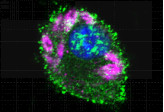Evaluation of the Effect of Cow’s Milk Kefir on Serum Tumor Necrosis Factor-alpha (TNF-α) and Expression of Inducible Nitric Oxide Synthase (iNOS) Gene in Liver Rats http://www.doi.org/10.26538/tjnpr/v7i5.7
Main Article Content
Abstract
TNF-α is a pro-inflammatory cytokine in insulin resistance. Cytokine-induced increase in TNF-α production by the iNOS pathway plays an important role in diabetes. This study was designed to determine the effect of cow's milk kefir as an antidiabetic and expression of the iNOS gene. Twenty-five Wistar rats were divided into 5 groups. Group cow’s milk kefir dose variation (50%, 75%, and 100%). This study showed that TNF-α levels in the DM control rat group were higher compared to other DM rat groups that were given cow’s milk kefir treatment. The cow's milk kefir treatment group (50%) had a higher average TNF-α content (146.3± 6.68) compared to the other two treatment groups given 75% cow's milk kefir (169.9± 6.39) and 100% cow's milk kefir (175.3± 4.66). There were differences in TNF-α levels between treatment groups (p=0.0013). The expression of the iNOS gene in the healthy control group was highest found in the M rat groupgiven 50% milk kefir and the lowest in the DM rat group given 100% milk kefir. There weresignificant differences in iNOS gene expression between groups (p = 0.0019). There was a significant difference between the DM rat group that was treated in the form of 50% group with DM Rats (positive controls) (p= 0.0048) and DM cow’s milk Kefir rats 75% milk with DM Rats (Positive controls) (p=0.0128). This study shows that there is an effect of cow's milk kefir as an antidiabetic on TNF-α and iNOS gene expression.
Downloads
Article Details

This work is licensed under a Creative Commons Attribution-NonCommercial-NoDerivatives 4.0 International License.
References
Akash MSH, Rehman K, Liaqat A. Tumor necrosis factor‐alpha: role in development of insulin resistance and pathogenesis of type 2 diabetes mellitus. J Cell Biochem. 2018;119(1):105–10. https://doi.org/10.1002/jcb.26174.
Tiwari AK, Rao JM. Diabetes mellitus and multiple therapeutic approaches of phytochemicals: Present status and future prospects. Curr Sci. 2002;30–8.
Elleder D, Kaspers B. After TNF-alpha, still playing hideand-seek with chicken genes. Poult Sci. 2019. https://doi.org/10.3382/ps/pez307.
Hasan R, Siregar GA, Lindarto D. Syzygium polyanthum reduced TNF-α and ADAM17 protein expression in myocardial infarction rat model. Med Arch. 2020;74(6):416. https://doi.org/10.5455/medarh.2020.74.416-420.
Javaid N, Patra MC, Seo H, Yasmeen F, Choi S. A rational insight into the effect of dimethyl sulfoxide on TNF-α activity. Int J Mol Sci. 2020;21(24):9450.
https://doi.org/10.3390/ijms21249450.
Ibikunle JB, Adebayo EA, Oke AM, Badmus JA, Yekeen TA, Kehinde DB. Anti-Diabetic Potential of Silver (AgNPs) and Gold (AuNPs) Nanoparticles Synthesized Using an Aqueous Extract of Opuntia ficus indica Cladodes in Wistar Rats. Trop J Nat Prod Res. 2022;6(7):1152–8.
https://doi.org/10.26538/tjnpr/v6i7.19.
Yedelli K, Pathangi RK. Antidiabetic Activity of Medicinal Plants: An Updated Overview of Streptozotocin and Alloxan-Induced Diabetic Models. Trop J Nat Prod Res. 2022;6(7):1047–56. https://doi.org/10.26538/tjnpr/v6i7.3.
Pongoh AF, de Queljoe E, Rotinsulu H. Uji Antidiabetik Ekstrak Etanol Bunga Pepaya (Carica papaya L.) terhadap Tikus Putih Jantan (Rattus norvegicus) yang Diinduksi Aloksan. PHARMACON. 2020;9(1):160–9. https://doi.org/10.35799/pha.9.2020.27423.
El-Shahawy AAG, Abdel-Moneim A, Ebeid ASM, Eldin ZE, Zanaty MI. A novel layered double hydroxide-hesperidin nanoparticles exert antidiabetic, antioxidant and antiinflammatory effects in rats with diabetes. Mol Biol Rep.2021;48:5217–32. https://doi.org/10.1007/s11033-021-
-2.
Nergiz İ, Başeskioğlu B, Yenilmez A, Erkasap N, Can C,Tosun M. Effects of rotenone on inducible nitric oxide synthase and cyclooxygenase-2 mRNA levels detected byreal-time PCR in a rat bladder ischemia/reperfusion model.Exp Ther Med. 2012;4(2):344–8. https://doi.org/10.3892/etm.2012.596.
Lin C, Guo Y, Xia Y, Li C, Xu X, Qi T, et al. FNDC5/Irisin attenuates diabetic cardiomyopathy in a type 2 diabetes mouse model by activation of integrin αV/β5-AKT signaling and reduction of oxidative/nitrosative stress. J Mol Cell Cardiol. 2021;160:27–41. https://doi.org/10.1016/j.yjmcc.2021.06.013.
Hadisaputro S, Djokomoeljanto RR, Soesatyo MH. The effects of oral plain kefir supplementation on proinflammatory cytokine properties of the hyperglycemia Wistar rats induced by streptozotocin. Acta Med Indones. 2012;44(2):100–4.
Artym J, Zimecki M, Paprocka M, Kruzel ML. Orally administered lactoferrin restores humoral immune response in immunocompromised mice. Immunol Lett. 2003;89(1):9– 15. https://doi.org/10.1016/S0165-2478(03)00102-0.
Astuti S. Soy Isoflavones and Their Potential as Free Radical Catchers. J Ind Technol Agric Prod. 2008;13:126–36.
Oteiza PI, Erlejman AG, Verstraeten S V, Keen CL, Fraga CG. Flavonoid-membrane interactions: a protective role of flavonoids at the membrane surface? Clin Dev Immunol. 2005;12(1):19–25. https://doi.org/10.1080/10446670410001722168


